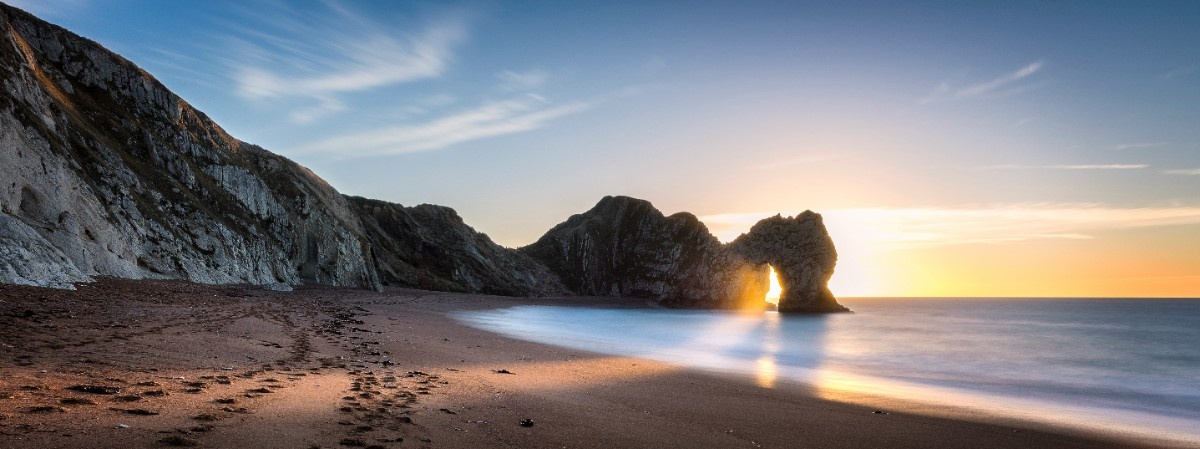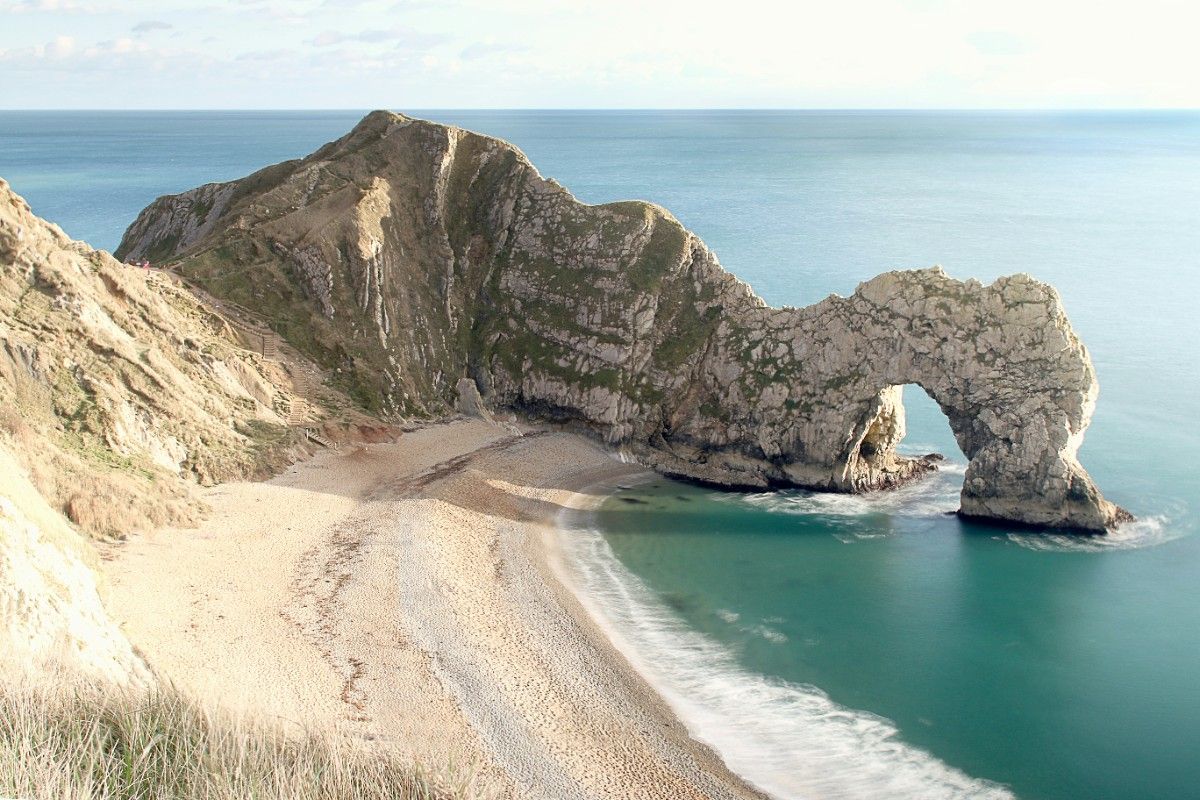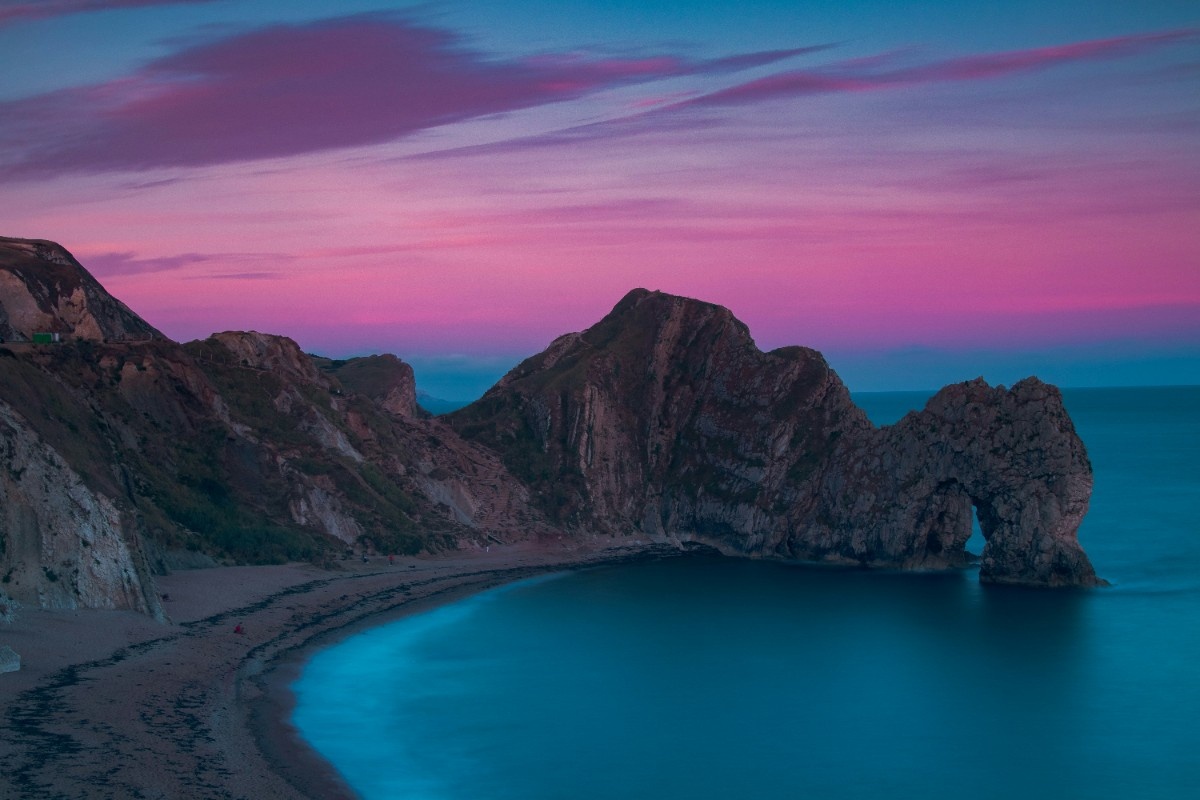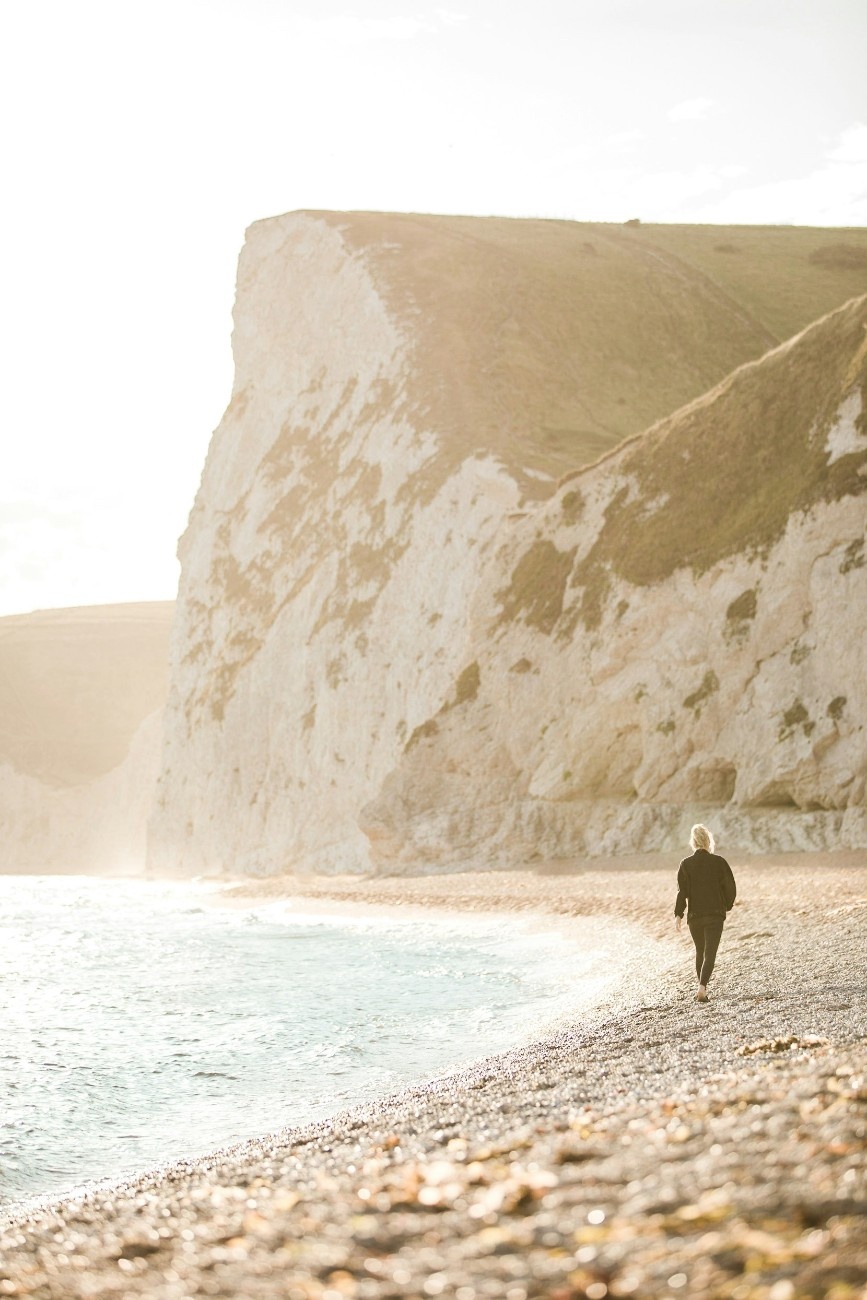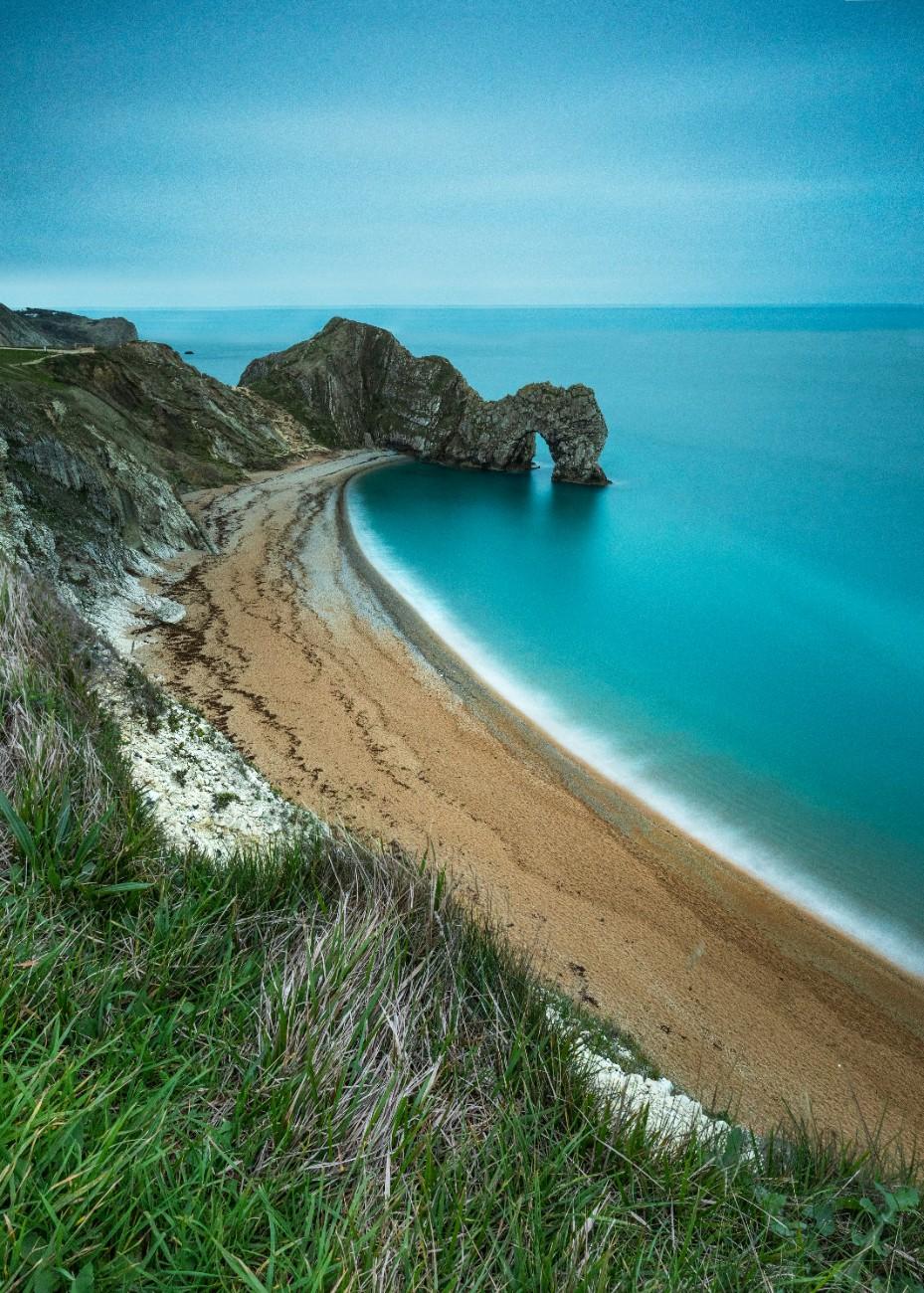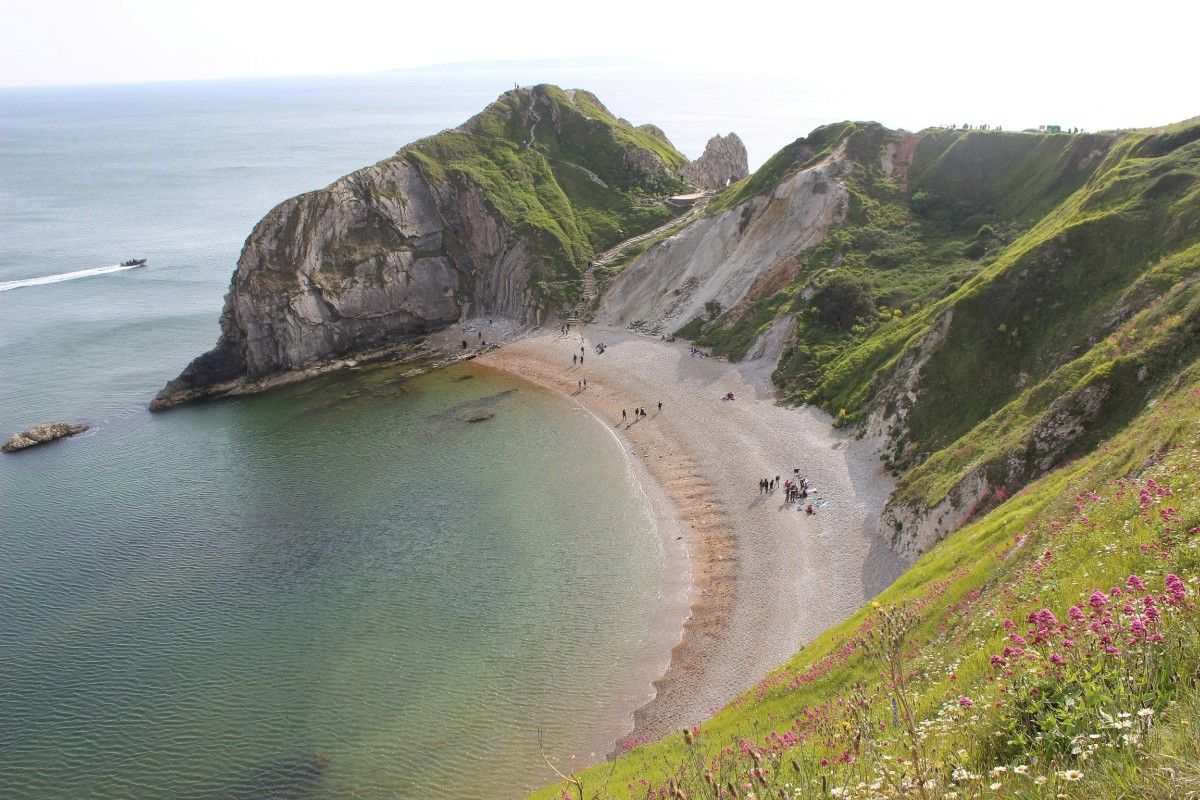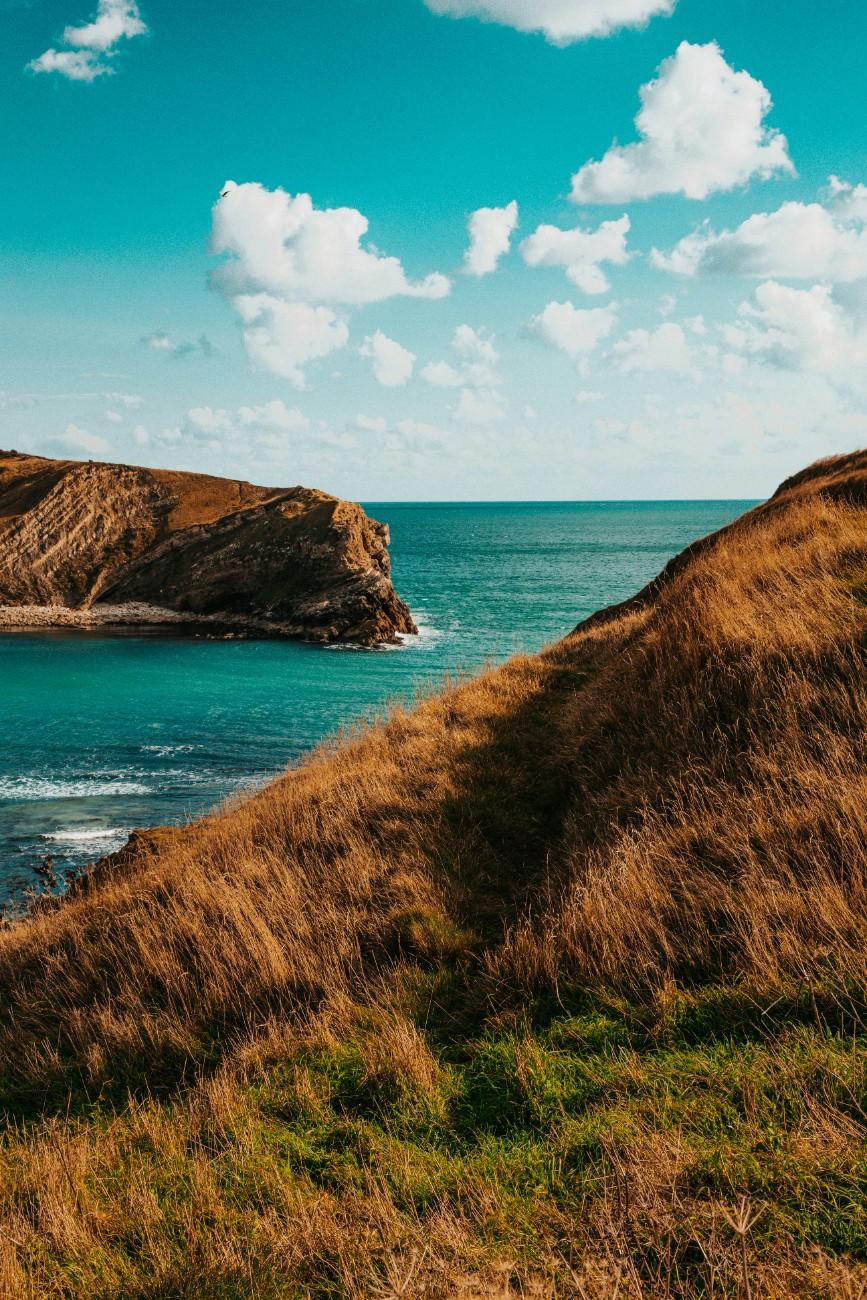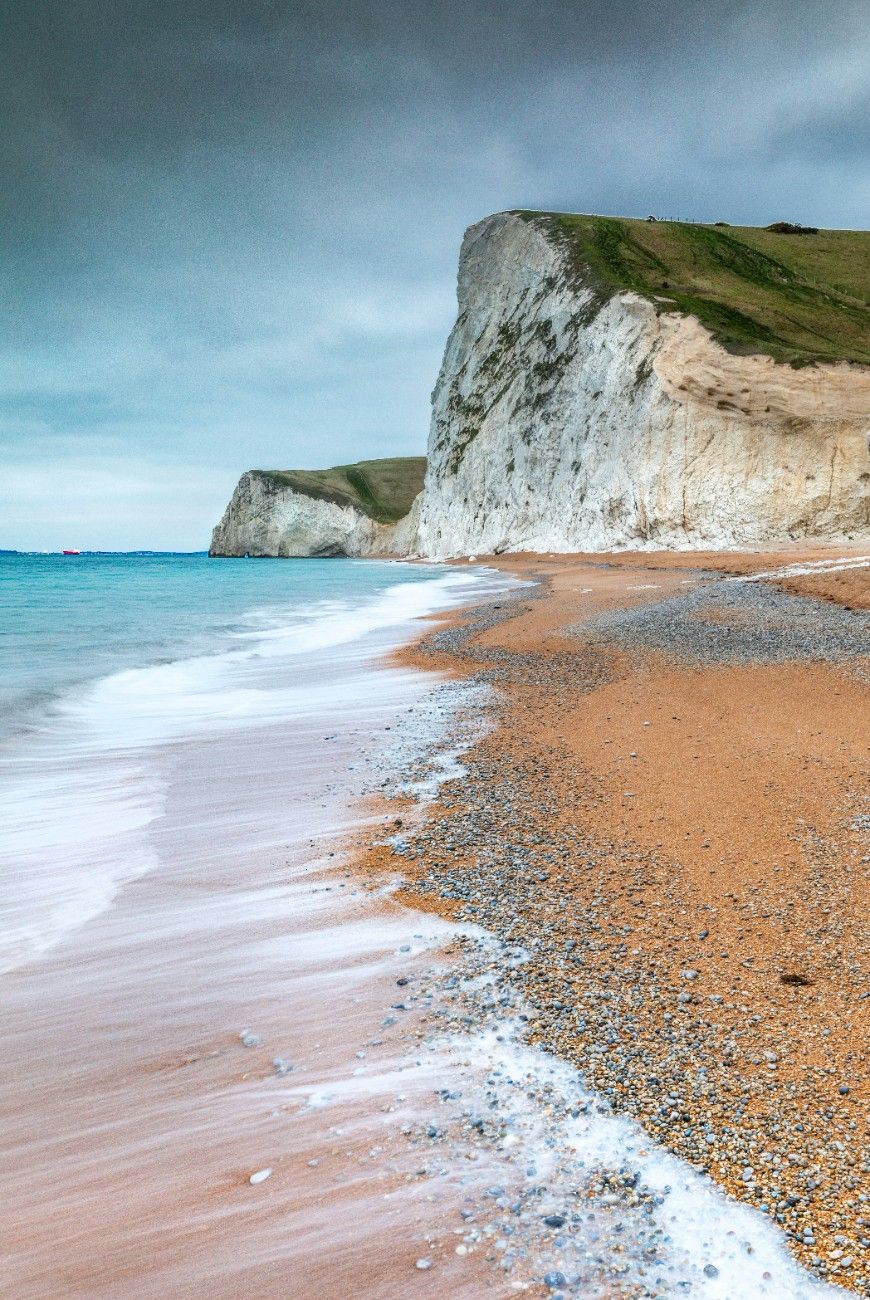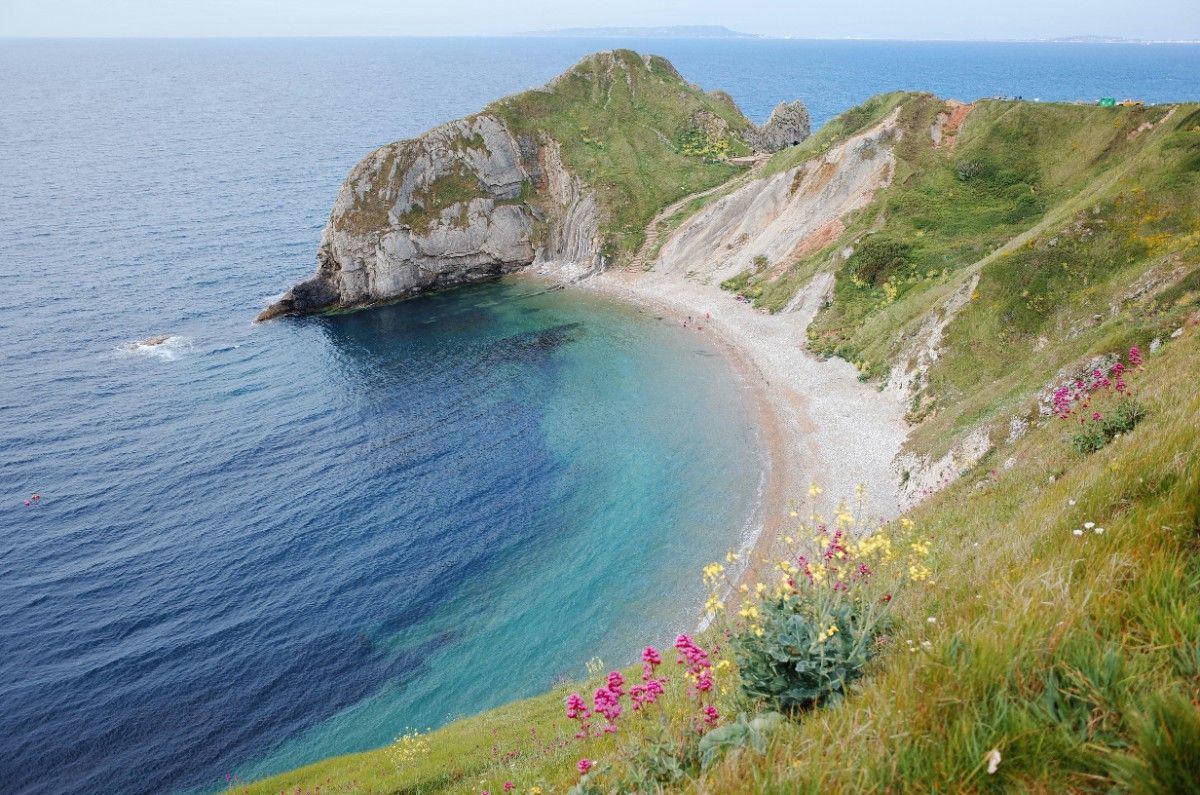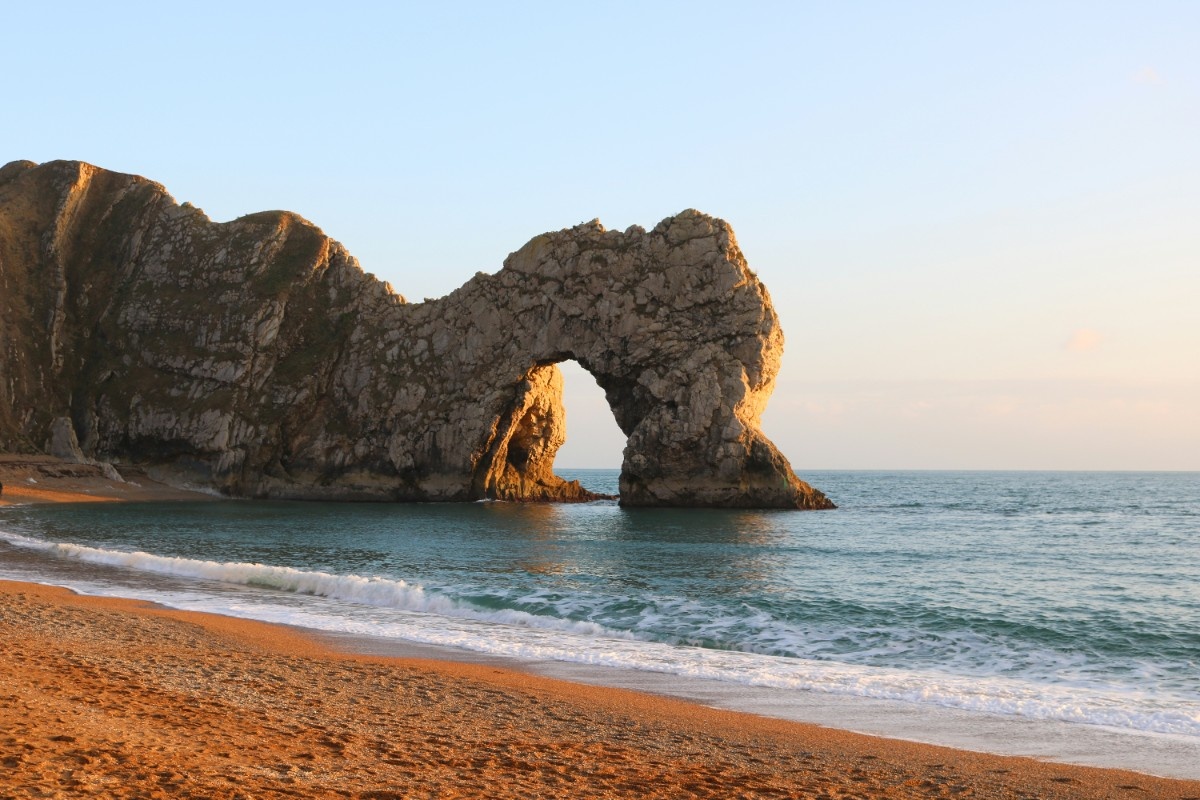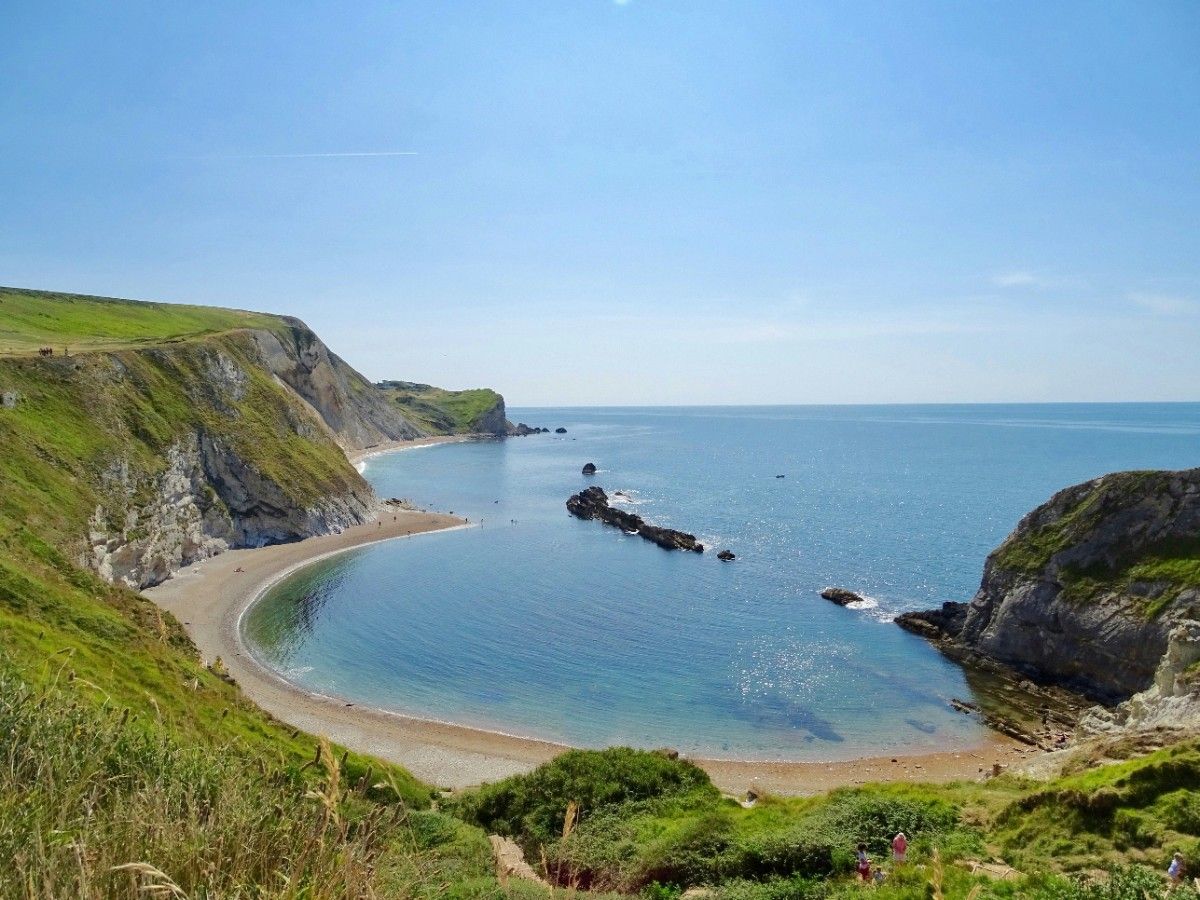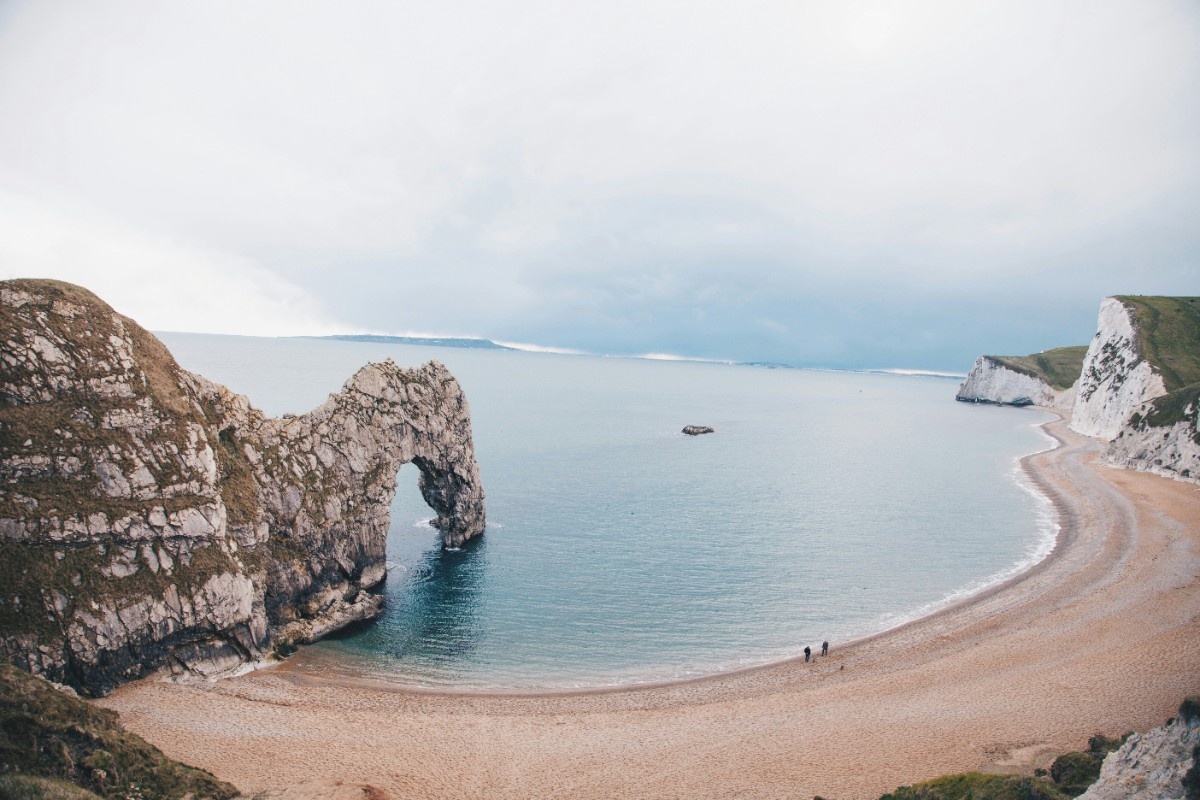Introduction to Durdle Door Beach
Overview of Durdle Door Beach
Durdle Door Beach, located on the stunning Jurassic Coast in Dorset, England, is a true natural wonder. This iconic beach is famous for its magnificent limestone arch, which has been carved out by the relentless forces of the sea over millions of years. The arch, known as Durdle Door, stands proudly amidst the crystal-clear turquoise waters and smooth pebble beach, creating a breathtaking sight that attracts visitors from all over the world.
The beach itself is a picturesque haven, with its pristine waters and captivating geological features. Visitors can enjoy a leisurely stroll along the shore, taking in the awe-inspiring beauty of the rugged coastline and the majestic cliffs that rise up behind the beach. The tranquil atmosphere and stunning natural surroundings make Durdle Door Beach an ideal spot for relaxation, contemplation, and reconnecting with nature.
Despite its remote location, Durdle Door Beach is easily accessible by car, with a dedicated car park located just a short walk from the shore. Visitors can follow the well-maintained path down to the beach, which offers breathtaking views of the coastline along the way. Once on the beach, visitors can explore the various rock formations, including the iconic Durdle Door itself, and even venture into the shallow waters for a refreshing dip.
The beach is also a popular spot for picnics, with plenty of scenic spots to lay down a blanket and enjoy a leisurely lunch while taking in the stunning views. With its idyllic setting and unparalleled natural beauty, Durdle Door Beach is a must-visit destination for anyone traveling to the Jurassic Coast or exploring the wonders of Dorset.
Location and How to Get There
Durdle Door Beach is situated along the Jurassic Coast, a 95-mile stretch of coastline in southern England that spans from East Devon to Dorset. The beach is located near the charming village of West Lulworth, approximately 12 miles east of the county town of Dorchester and 5 miles west of the town of Wareham.
For those traveling by car, the postcode for Durdle Door Beach is BH20 5PU. Visitors can follow the signs for Lulworth Cove and Durdle Door, which will lead them to the designated car park. The car park is located at the top of the cliffs, and from there, it is a short walk down to the beach itself. It is important to note that the path to the beach is steep and uneven in places, so visitors should wear sturdy footwear and exercise caution.
For those traveling by public transport, the nearest train station is Wool, which is located approximately 5 miles from Durdle Door Beach. From the train station, visitors can take a taxi or a bus to the beach. The X55 bus service runs from Weymouth to Bovington and stops at the Durdle Door Holiday Park, which is just a short walk from the beach.
Once at the beach, visitors can explore the surrounding area and take in the stunning views of the coastline. The South West Coast Path, a long-distance walking trail, runs along the cliffs above the beach and offers breathtaking views of the arch and the sea. Visitors can also explore the nearby Lulworth Cove, another natural wonder of the Jurassic Coast, which is just a short drive or walk from Durdle Door Beach.
Geological Significance of Durdle Door Beach
Formation of the Limestone Arch
Durdle Door Beach is a geological masterpiece that showcases the incredible power of nature. The star attraction of the beach is undoubtedly the iconic limestone arch, known as Durdle Door, which has been shaped by the relentless forces of the sea over millions of years.
The formation of Durdle Door is a testament to the complex geological processes that have shaped the Jurassic Coast. The arch is made up of a hard limestone layer that has been gradually eroded by the waves, while the softer rocks beneath have been worn away more quickly. Over time, this differential erosion has created a natural arch that stands proudly amidst the crashing waves.
The limestone that makes up Durdle Door is part of the Purbeck Beds, a series of sedimentary rocks that were formed during the Jurassic and Cretaceous periods, between 201 and 66 million years ago. These rocks are made up of layers of limestone, shale, and other sedimentary materials that were deposited in a shallow sea that once covered the area.
Over millions of years, the Purbeck Beds have been uplifted and folded by the earth's tectonic forces, creating the distinctive layered appearance of the cliffs that surround Durdle Door Beach. The arch itself is made up of a hard, durable limestone layer known as the Portland Stone, which has been able to resist the erosive power of the sea for longer than the softer rocks beneath it.
As the waves continue to crash against the cliffs and the arch, the shape of Durdle Door is constantly changing. The arch is gradually being worn away, and it is estimated that it will eventually collapse into the sea, creating a new stack or stump in its place. This is a natural process that has been shaping the Jurassic Coast for millions of years, and it is a testament to the incredible power and beauty of the natural world.
Importance of the Jurassic Coast
Durdle Door Beach is just one small part of the much larger Jurassic Coast, a 95-mile stretch of coastline that has been designated a UNESCO World Heritage Site due to its incredible geological significance. The Jurassic Coast is a unique and unparalleled record of the earth's history, spanning over 185 million years of geological time.
The rocks and fossils found along the Jurassic Coast provide a fascinating insight into the changing environments and ecosystems of the past. The coast is named after the Jurassic period, which lasted from 201 to 145 million years ago, but it also includes rocks from the Triassic and Cretaceous periods, creating a complete record of the Mesozoic era.
The Jurassic Coast is home to an incredible diversity of geological features, including towering cliffs, sea stacks, natural arches, and hidden coves. These features have been created by the constant interplay of the sea, the rocks, and the tectonic forces that have shaped the earth over millions of years.
One of the most significant aspects of the Jurassic Coast is its wealth of fossils. The rocks along the coast are packed with the remains of ancient creatures that lived in the seas and on the land millions of years ago. These fossils include everything from tiny marine microorganisms to giant marine reptiles, such as ichthyosaurs and plesiosaurs.
The fossils found along the Jurassic Coast have played a crucial role in our understanding of the history of life on earth. They have helped scientists to reconstruct ancient ecosystems, understand the evolution of different species, and even discover new species that were previously unknown to science.
The Jurassic Coast is also an important site for geologists and earth scientists, who come from all over the world to study its unique geological features and processes. The coast provides an unparalleled opportunity to observe and study the complex interactions between the earth's tectonic plates, the sea, and the atmosphere over millions of years.
Overall, the Jurassic Coast is a truly remarkable and significant natural wonder that has much to teach us about the history and evolution of our planet. Durdle Door Beach is just one small part of this incredible coastline, but it is a stunning example of the geological processes that have shaped the earth over millions of years.
Exploring the Beach and Surrounding Area
Discovering the Beach and Its Unique Features
Durdle Door Beach is a spectacular destination that offers visitors a chance to explore a truly unique coastal environment. The beach itself is a stunning sight, with its clear turquoise waters and smooth pebbles that create a satisfying crunch underfoot. The iconic limestone arch, known as Durdle Door, is an awe-inspiring feature that draws visitors from all over the world.
One of the best ways to experience the beauty of Durdle Door Beach is to simply take a leisurely stroll along the shore. The beach stretches for approximately half a mile, and visitors can walk from one end to the other, taking in the stunning views of the Jurassic Coast and the sea. Along the way, visitors can explore the various rock formations and cliffs that make up the coastline, including the towering limestone cliffs that rise up behind the beach.
For those who are feeling more adventurous, Durdle Door Beach also offers plenty of opportunities for swimming and snorkelling. The clear waters of the English Channel are relatively calm and shallow near the shore, making it a great spot for a refreshing dip on a hot summer day. Visitors can also explore the underwater world by snorkelling or diving, discovering the vibrant marine life that inhabits the rocky reefs and seagrass beds just offshore.
Another popular activity at Durdle Door Beach is rock pooling. The rocky shores of the beach are home to a fascinating array of marine creatures, including crabs, starfish, and sea anemones. Visitors can spend hours exploring the pools and crevices, discovering the hidden wonders of the intertidal zone.
Of course, no visit to Durdle Door Beach would be complete without taking plenty of photos of the iconic limestone arch. The arch is a photographer's dream, with its graceful curves and stunning natural beauty. Visitors can capture the arch from a variety of angles, from the beach itself or from the cliff tops above, creating a truly unforgettable memory of their visit to this spectacular destination.
Hiking the South West Coast Path
For those who want to explore the stunning scenery of the Jurassic Coast beyond Durdle Door Beach, the South West Coast Path is a must-visit attraction. This 630-mile trail runs along the entire length of the southwest coast of England, from Somerset to Dorset, and offers some of the most breathtaking coastal views in the country.
The section of the South West Coast Path that runs through Durdle Door is particularly scenic, with the iconic limestone arch providing a stunning backdrop for the hike. The trail runs along the cliff tops above the beach, offering panoramic views of the coastline and the sea. Visitors can hike in either direction from Durdle Door, exploring the rugged beauty of the Jurassic Coast and discovering hidden coves and beaches along the way.
One of the highlights of hiking the South West Coast Path near Durdle Door is the chance to see some of the area's unique wildlife. The cliffs and grasslands along the trail are home to a variety of rare and endangered species, including the Lulworth skipper butterfly and the Adonis blue butterfly. Visitors may also spot seabirds such as guillemots and razorbills nesting on the cliffs, or even catch a glimpse of a peregrine falcon soaring overhead.
Hiking the South West Coast Path is a great way to experience the natural beauty of the Jurassic Coast and get some exercise at the same time. The trail is well-maintained and clearly marked, but it can be challenging in places, with steep ascents and descents. Visitors should wear sturdy hiking shoes and bring plenty of water and snacks for the journey.
Whether you're a seasoned hiker or just looking for a scenic walk, the South West Coast Path near Durdle Door is a must-visit attraction. With its stunning coastal views, unique wildlife, and fascinating geological features, this section of the trail offers a truly unforgettable experience for visitors to the Jurassic Coast.
Wildlife and Conservation at Durdle Door Beach
Marine Life and Coastal Habitats
Durdle Door Beach and the surrounding coastal areas are home to a diverse array of marine life and unique coastal habitats. The clear waters of the English Channel provide a perfect environment for a variety of sea creatures, from colourful fish and crustaceans to fascinating molluscs and echinoderms.
One of the most iconic species found at Durdle Door Beach is the common sea star, also known as the starfish. These beautiful creatures can be found clinging to rocks and seaweed in the intertidal zone, and come in a range of colours from bright orange to deep purple. Visitors can also spot a variety of crabs and lobsters scuttling along the seafloor, as well as sea urchins and sea cucumbers hiding amongst the rocks.
The seagrass beds that lie just offshore from Durdle Door Beach are another important habitat for marine life. These underwater meadows provide a nursery ground for many species of fish and invertebrates, as well as a food source for larger creatures like seahorses and sea turtles. The seagrass beds also play a crucial role in stabilising the seafloor and reducing coastal erosion.
In addition to the marine life, Durdle Door Beach is also home to a variety of coastal bird species. The cliffs that rise up behind the beach provide nesting sites for seabirds like guillemots and razorbills, which can be seen soaring over the water in search of food. Visitors may also spot oystercatchers and other wading birds foraging along the shoreline at low tide.
The unique geology of Durdle Door Beach also creates a range of microhabitats that support a variety of plant and animal species. The limestone cliffs are home to rare and endangered wildflowers like the early spider orchid and the Lulworth skipper butterfly, while the rock pools and crevices provide shelter for small fish and invertebrates.
Overall, the marine life and coastal habitats found at Durdle Door Beach are a testament to the incredible diversity and resilience of nature. By protecting and conserving these unique ecosystems, we can ensure that future generations will be able to experience the wonder and beauty of this spectacular destination.
Conservation Efforts and Responsible Tourism
As one of the most popular destinations on the Jurassic Coast, Durdle Door Beach faces a range of challenges when it comes to conservation and responsible tourism. The high volume of visitors to the beach each year can put pressure on the delicate ecosystems and natural features of the area, making it essential to promote sustainable tourism practices and support conservation efforts.
One of the main organisations working to protect and conserve Durdle Door Beach and the wider Jurassic Coast is the Jurassic Coast Trust. This charitable organisation works to promote responsible tourism, support scientific research and education, and engage local communities in the conservation of this unique natural wonder.
The Jurassic Coast Trust works closely with local authorities and landowners to manage visitor access to sensitive areas and promote sustainable tourism practices. This includes measures like designated parking areas, marked trails, and educational signage to help visitors understand and appreciate the natural features of the area without causing damage or disturbance.
In addition to these practical measures, the Jurassic Coast Trust also works to raise awareness about the importance of conservation and responsible tourism through educational programs and outreach events. By engaging visitors and local communities in the protection and stewardship of Durdle Door Beach and the wider Jurassic Coast, the Trust hopes to create a culture of conservation that will ensure the long-term survival of this incredible natural resource.
Visitors to Durdle Door Beach can also play a role in supporting conservation efforts by practicing responsible tourism behaviours. This includes following designated trails and pathways, avoiding disturbing wildlife or damaging natural features, and properly disposing of waste and litter. By being mindful of their impact on the environment and supporting local conservation efforts, visitors can help ensure that Durdle Door Beach remains a spectacular and unspoiled destination for generations to come.
Overall, the conservation and protection of Durdle Door Beach and the wider Jurassic Coast is a shared responsibility that requires the cooperation and engagement of visitors, local communities, and conservation organisations alike. By working together to promote sustainable tourism practices and support scientific research and education, we can ensure that this incredible natural wonder remains a source of inspiration and wonder for years to come.
Photography and Filming at Durdle Door Beach
Capturing the Perfect Shot
Durdle Door Beach is a photographer's paradise, offering a stunning backdrop for capturing unforgettable images. The iconic limestone arch, crystal-clear waters, and rugged coastline provide endless opportunities for both amateur and professional photographers alike.
One of the best times to photograph Durdle Door is during the golden hours, which occur just after sunrise and before sunset. During these times, the light is soft and warm, casting a beautiful glow on the landscape and creating long shadows that add depth and dimension to the scene. Photographers can capture the arch from various angles, showcasing its unique shape and the way the light plays off its surface.
Another popular subject for photography at Durdle Door Beach is the crystal-clear turquoise waters. The water here is so transparent that you can often see straight through to the bottom, creating a mesmerising effect that is perfect for capturing with a camera. Photographers can experiment with different shutter speeds to create a sense of motion in the water or use a polarising filter to reduce glare and enhance the natural colours of the sea.
For those interested in landscape photography, the Jurassic Coast offers a wealth of opportunities. The rugged cliffs and rock formations create a dramatic backdrop for photos, while the lush green countryside provides a stunning contrast to the blue of the sea. Photographers can hike along the South West Coast Path to find unique vantage points and capture panoramic views of the coastline.
When photographing at Durdle Door Beach, it is essential to be mindful of the tides and weather conditions. The beach is only accessible during low tide, so photographers need to plan their visits accordingly. It is also important to check the weather forecast before heading out, as the coastline can be dangerous during storms or high winds.
Overall, Durdle Door Beach is a photographer's dream, offering endless opportunities for capturing stunning images of one of the most beautiful natural wonders in the UK. Whether you are a seasoned professional or an amateur enthusiast, this iconic location is sure to inspire and delight you with its incredible beauty and unique character.
Durdle Door as a Popular Filming Location
In addition to being a popular spot for photography, Durdle Door Beach has also been a favourite location for filmmakers and television producers. The unique geology and stunning natural beauty of the area have made it a sought-after backdrop for a range of productions, from Hollywood blockbusters to music videos and commercials.
One of the most famous films to feature Durdle Door Beach is the 1967 adaptation of Thomas Hardy's novel "Far from the Madding Crowd." The beach and surrounding coastline were used as a location for several key scenes in the film, showcasing the rugged beauty of the Dorset countryside. The film's success helped to put Durdle Door on the map and solidified its reputation as a stunning natural wonder.
More recently, Durdle Door Beach has been featured in a number of popular television series, including "Broadchurch" and "The Crown." The beach's dramatic cliffs and turquoise waters have provided a stunning backdrop for these productions, adding to the sense of atmosphere and setting.
In addition to feature films and television series, Durdle Door Beach has also been used as a location for music videos and commercials. The unique geology of the area, with its rocky cliffs and clear waters, provides a striking visual contrast that is perfect for creating memorable and impactful imagery.
Despite its popularity as a filming location, Durdle Door Beach remains a protected and cherished natural site. The Jurassic Coast Trust works closely with production companies to ensure that filming activities do not harm the delicate ecosystems or natural features of the area. Filmmakers are required to follow strict guidelines and obtain the necessary permits before shooting at Durdle Door, helping to ensure that this incredible location remains unspoiled for generations to come.
Overall, Durdle Door Beach is a truly unique and iconic filming location that has captured the imagination of audiences around the world. Its stunning natural beauty and dramatic geology make it a versatile and unforgettable backdrop for a range of productions, from sweeping historical dramas to contemporary thrillers and everything in between. As a result, this incredible location is sure to remain a favourite among filmmakers and television producers for years to come, cementing its place as one of the most iconic and recognisable natural wonders in the UK.
Visiting Durdle Door Beach
Planning Your Trip
If you're planning a visit to Durdle Door Beach, there are a few key things to keep in mind to ensure that you have a safe and enjoyable experience. The first step is to decide when to visit. Durdle Door Beach is a popular destination year-round, but the peak season is during the summer months of June, July, and August. During this time, the weather is generally warm and sunny, making it perfect for swimming, sunbathing, and exploring the coastline.
However, the summer months can also be extremely busy, with large crowds and limited parking. If you prefer a quieter experience, consider visiting during the shoulder season in May or September, when the weather is still pleasant but the crowds are smaller.
Once you've decided when to visit, the next step is to plan your journey. Durdle Door Beach is located in the county of Dorset, approximately 3 hours' drive from London. If you're traveling by car, you can use the postcode BH20 5PU to guide you to the Durdle Door Holiday Park, where you'll find a designated car park for beach visitors.
If you're traveling by public transport, the nearest train station is Wool, which is approximately 5 miles away from Durdle Door Beach. From there, you can take a taxi or bus to reach the beach.
When planning your trip, it's also important to consider your accommodation options. There are several hotels and holiday parks in the area surrounding Durdle Door Beach, ranging from budget-friendly options to luxurious resorts. Some popular options include the Durdle Door Holiday Park, the Lulworth Cove Inn, and the Limestone Hotel.
Regardless of where you choose to stay, be sure to book your accommodation well in advance, especially during peak season. Many hotels and holiday parks fill up quickly, so it's important to plan ahead to ensure that you have a comfortable and convenient place to stay during your visit.
What to Expect When You Arrive
When you arrive at Durdle Door Beach, the first thing you'll notice is the stunning natural beauty of the area. The iconic limestone arch is visible from the car park, and the crystal-clear waters of the English Channel stretch out as far as the eye can see.
To reach the beach itself, you'll need to follow a steep path down from the car park. The path is well-maintained but can be challenging for those with mobility issues or young children. Be sure to wear sturdy shoes and take your time on the descent.
Once you reach the beach, you'll be greeted by a wide expanse of smooth pebbles and crystal-clear water. The beach is approximately half a mile long and is backed by towering cliffs that rise up to 200 feet above the shoreline.
One of the main attractions of Durdle Door Beach is the opportunity to swim in the clear turquoise waters. The water is generally calm and shallow near the shore, making it a popular spot for families with young children. However, it's important to be aware of the tides and currents, as they can be strong in certain areas.
If you're feeling adventurous, you can also explore the rocky cliffs and caves that surround the beach. The limestone cliffs are popular with rock climbers, who come from all over the world to test their skills on the challenging routes. However, it's important to note that climbing the cliffs can be dangerous and should only be attempted by experienced climbers with the proper equipment and training.
In addition to swimming and climbing, there are plenty of other activities to enjoy at Durdle Door Beach. Many visitors choose to simply relax on the pebbles and soak up the sun, while others enjoy exploring the rock pools and searching for fossils along the shoreline.
If you're planning to spend the whole day at the beach, be sure to pack plenty of water, snacks, and sunscreen. There are no facilities at Durdle Door Beach, so you'll need to bring everything you need with you.
Overall, visiting Durdle Door Beach is an unforgettable experience that offers a chance to connect with nature and marvel at the incredible beauty of the Jurassic Coast. Whether you're a seasoned adventurer or simply looking for a peaceful escape from the city, this iconic destination is sure to leave a lasting impression on all who visit.
Accessibility and Safety at Durdle Door Beach
Accessibility Considerations
Durdle Door Beach is a stunning natural wonder that attracts visitors from all over the world. However, it's important to note that the beach and surrounding area can be challenging for those with mobility issues or disabilities.
The main access point to Durdle Door Beach is via a steep path from the car park at the top of the cliffs. The path is well-maintained but can be difficult to navigate for those with limited mobility. There are several steps and uneven surfaces along the way, and the descent can be slippery in wet weather.
Unfortunately, there are no wheelchair-accessible paths or facilities at Durdle Door Beach. The pebble beach itself can also be challenging to walk on, particularly for those with mobility issues.
However, there are still ways for visitors with disabilities to enjoy the stunning views of Durdle Door and the Jurassic Coast. The Durdle Door Holiday Park offers accessible accommodation options, and there are several viewpoints along the cliff tops that provide stunning views of the coastline without requiring a steep descent to the beach.
For those who are able to make the journey down to the beach, it's important to be aware of the tides and weather conditions. The beach is only accessible during low tide, and visitors should always check the tide times before setting out. It's also important to be aware of the potential for strong currents and waves, particularly during stormy weather.
Overall, while Durdle Door Beach may not be the most accessible destination, there are still ways for visitors with disabilities to enjoy the stunning natural beauty of the area. By planning ahead and being aware of the challenges and limitations, visitors can ensure a safe and enjoyable experience at this iconic location.
Safety Considerations
While Durdle Door Beach is a stunning natural wonder, it's important to be aware of the potential safety risks associated with visiting this iconic location. The rugged coastline and powerful waves can pose challenges for even the most experienced swimmers and hikers, and it's essential to take precautions to ensure a safe and enjoyable visit.
One of the biggest safety concerns at Durdle Door Beach is the risk of falling from the cliffs. The limestone cliffs that surround the beach are prone to erosion and can be unstable, particularly after heavy rain or stormy weather. Visitors should always stay well back from the edge of the cliffs and avoid climbing or walking too close to the edge.
Another safety risk at Durdle Door Beach is the potential for strong currents and powerful waves. The beach is exposed to the full force of the Atlantic Ocean, and the waves can be unpredictable and dangerous, particularly during stormy weather. Visitors should always check the weather forecast and tide times before setting out and avoid swimming or wading in the water during rough conditions.
It's also important to be aware of the risk of rock falls and landslides at Durdle Door Beach. The limestone cliffs are constantly being eroded by the wind and waves, and large rocks and boulders can occasionally break off and fall onto the beach below. Visitors should always stay alert and be aware of their surroundings, particularly when walking along the base of the cliffs.
In addition to these natural hazards, there are also several man-made safety risks to be aware of at Durdle Door Beach. The beach can get very busy during peak season, and there have been instances of overcrowding and anti-social behaviour in the past. Visitors should always be respectful of others and take care to dispose of litter and waste responsibly.
Despite these safety concerns, Durdle Door Beach remains a popular and beloved destination for visitors from all over the world. By taking sensible precautions and being aware of the potential risks, visitors can ensure a safe and enjoyable experience at this stunning natural wonder. Whether you're a seasoned hiker or a first-time visitor, Durdle Door Beach is sure to leave a lasting impression and provide memories that will last a lifetime.
The Future of Durdle Door Beach
Sustainable Tourism
As one of the most popular destinations on the Jurassic Coast, Durdle Door Beach faces a range of challenges when it comes to sustainable tourism and conservation. With over 500,000 visitors each year, the beach and surrounding area are under constant pressure from foot traffic, litter, and erosion.
To address these challenges, the Jurassic Coast Trust and local authorities are working to promote sustainable tourism practices and encourage responsible visitor behaviour. This includes measures such as designated walking routes, parking restrictions, and educational signage to help visitors understand the importance of protecting this fragile natural environment.
One of the key priorities for sustainable tourism at Durdle Door Beach is to reduce the impact of visitor traffic on the delicate ecosystems and geological features of the area. This includes measures such as encouraging visitors to stick to designated paths and trails, promoting the use of public transport and car-sharing, and providing facilities for responsible waste disposal.
Another important aspect of sustainable tourism at Durdle Door Beach is to support the local economy and community. Many local businesses, including hotels, restaurants, and tour operators, rely on tourism for their livelihoods, and it's essential to ensure that the benefits of tourism are shared fairly and sustainably.
To this end, the Jurassic Coast Trust and local authorities are working to promote local products and services, encourage visitors to support local businesses, and develop sustainable tourism infrastructure that benefits both visitors and residents.
Overall, the future of Durdle Door Beach depends on finding a balance between protecting this stunning natural wonder and promoting sustainable tourism that benefits both visitors and the local community. By working together to promote responsible visitor behaviour, support local businesses, and conserve the delicate ecosystems and geological features of the area, we can ensure that Durdle Door Beach remains a beloved and sustainable destination for generations to come.
Conservation and Protection
In addition to promoting sustainable tourism, the future of Durdle Door Beach also depends on ongoing conservation and protection efforts to safeguard this unique and fragile natural environment.
One of the biggest challenges facing Durdle Door Beach is the impact of climate change and rising sea levels. As global temperatures continue to rise, the risk of coastal erosion, landslides, and flooding is increasing, posing a serious threat to the delicate ecosystems and geological features of the Jurassic Coast.
To address these challenges, the Jurassic Coast Trust and local authorities are working to develop long-term strategies for coastal management and adaptation. This includes measures such as monitoring and assessing the impacts of climate change, developing contingency plans for extreme weather events, and investing in sustainable coastal defence infrastructure.
Another key aspect of conservation and protection at Durdle Door Beach is to promote scientific research and education. The Jurassic Coast is a globally significant site for geological and paleontological research, and it's essential to ensure that this research continues and is shared with the public.
To this end, the Jurassic Coast Trust and local universities are working to promote scientific research and education at Durdle Door Beach and the wider Jurassic Coast. This includes initiatives such as guided walks and talks, educational exhibits, and citizen science projects that engage visitors and local communities in the conservation and protection of this unique natural environment.
Overall, the future of Durdle Door Beach depends on ongoing conservation and protection efforts to safeguard this stunning natural wonder for generations to come. By working together to monitor and assess the impacts of climate change, promote scientific research and education, and develop sustainable coastal management strategies, we can ensure that Durdle Door Beach remains a beloved and protected destination for visitors and researchers alike.
At the same time, it's important to recognise that conservation and protection efforts at Durdle Door Beach are part of a wider global effort to address the challenges of climate change and protect our planet's most valuable natural resources. By working together at a local, national, and international level to promote sustainable tourism, scientific research, and environmental protection, we can help to ensure a brighter future for Durdle Door Beach and the countless other natural wonders that make our world so special.
Related Articles

Let us know you agree to cookies
We use marketing, analytical and functional cookies as well as similar technologies to give you the best experience. Third parties, including social media platforms, often place tracking cookies on our site to show you personalised adverts outside of our website.
We store your cookie preferences for two years and you can edit your preferences via ‘manage cookies’ or through the cookie policy at the bottom of every page. For more information, please see our cookie policy.
